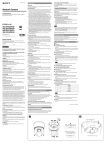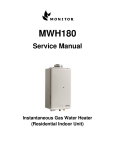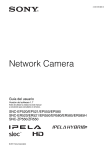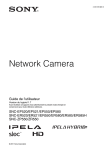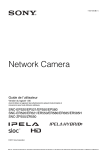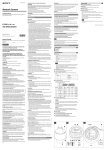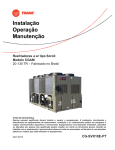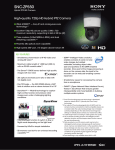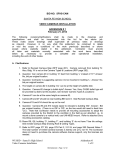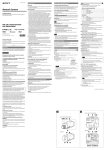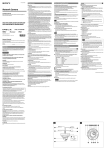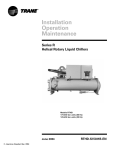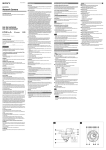Download Installation guide
Transcript
4-282-057-13 (1) Notes on Use Before Use If you find condensation when you open the package, turn on the power after the condensation disappears. Network Camera Installation Manual Before operating the unit, please read this manual thoroughly and retain it for future reference. SNC-EP580/ER580/EP550/ER550 SNC-EP520/ER520/EP521/ER521 SNC-ZP550/ZR550 2011 Sony Corporation Data and security Since the service is Internet-based, there is a risk that the image or audio you are monitoring can be viewed or used by a third-party via the network. You should keep in mind that the images or audio you are monitoring may be protected by privacy and other legal rights, and the responsibility for making sure you are complying with applicable laws is yours alone. Access to the images and audio is protected only by a user name and the password you set up. No further authentication is provided nor should you presume that any other protective filtering is done by the service. SONY IS NOT RESPONSIBLE, AND ASSUMES ABSOLUTELY NO LIABILITY TO YOU OR ANYONE ELSE, FOR SERVICE INTERRUPTIONS OR DISCONTINUATIONS OR EVEN SERVICE CANCELLATION. THE SERVICE IS PROVIDED AS-IS, AND SONY DISCLAIMS AND EXCLUDES ALL WARRANTIES, EXPRESS OR IMPLIED, WITH RESPECT TO THE SERVICE INCLUDING, BUT NOT LIMITED TO, ANY OR ALL IMPLIED WARRANTIES OF MERCHANTABILITY, FITNESS FOR A PARTICULAR PURPOSE, OR THAT IT WILL OPERATE ERROR-FREE OR CONTINUOUSLY. Always make a test recording, and verify that it was recorded successfully. SONY WILL NOT BE LIABLE FOR DAMAGES OF ANY KIND INCLUDING, BUT NOT LIMITED TO, COMPENSATION OR REIMBURSEMENT ON ACCOUNT OF FAILURE OF THIS UNIT OR ITS RECORDING MEDIA, EXTERNAL STORAGE SYSTEMS OR ANY OTHER MEDIA OR STORAGE SYSTEMS TO RECORD CONTENT OF ANY TYPE. Always verify that the unit is operating properly before use. SONY WILL NOT BE LIABLE FOR DAMAGES OF ANY KIND INCLUDING, BUT NOT LIMITED TO, COMPENSATION OR REIMBURSEMENT ON ACCOUNT OF THE LOSS OF PRESENT OR PROSPECTIVE PROFITS DUE TO FAILURE OF THIS UNIT, EITHER DURING THE WARRANTY PERIOD OR AFTER EXPIRATION OF THE WARRANTY, OR FOR ANY OTHER REASON WHATSOEVER. If you lose data by using this unit, SONY accepts no responsibility for restoration of the data. Personal information Printed in Japan Owner’s Record The model and serial numbers are located on the bottom. Record these numbers in the spaces provided below. Refer to these numbers whenever you call upon your Sony dealer regarding this product. Model No. Serial No. Overview This Installation Manual gives instructions for multiple types of Network Cameras: SNC-EP520/EP521/ER520/ER521 are SD models, SNC-EP550/ER550 are HD models, SNC-EP580/ER580 are Full HD models, and SNC-ZP550/ZR550 are HD model IPELA HYBRID-compatible cameras. The images taken by the system using this device can identify individuals and thus they fall under “personal information” stipulated in the “Act on the Protection of Personal Information”. Please handle the video data appropriately according to law. Information recorded using this product may also be “personal information”. Upon disposal, transfer, repair, or any other occasion where this product or storage media is passed on to a third party, practice due care in its handling. Operating or storage location Avoid operating or storing the camera in the following locations. Extremely hot or cold places Exposed to direct sunlight for a long time, or close to heating equipment (e.g., near heaters) Close to sources of strong magnetism Close to sources of powerful electromagnetic radiation, such as radios or TV transmitters Locations subject to vibration or shock Humid or dusty locations Locations exposed to rain WARNING Ventilation To reduce the risk of fire or electric shock, do not expose this apparatus to rain or moisture. Power supply To avoid electrical shock, do not open the cabinet. Refer servicing to qualified personnel only. CAUTION To prevent heat buildup, do not block air circulation around the camera. The power is supplied via a network cable, when the camera operates using HPoE (High-Power-over-Ethernet). Use STP/UTP Category 5 network cable. Using a damaged network cable may cause a risk of fire or electric shock. This installation should be made by a qualified service person and should conform to all local codes. WARNING Cleaning WARNING (for Installers only) Instructions for installing the equipment on the ceiling: After the installation, ensure the connection is capable of supporting five times the weight of the equipment downwards. CAUTION The rating label is located on the bottom. CAUTION for LAN port For safety reason, do not connect the LAN port to any network devices that might have excessive voltage. The LAN port of this unit is to be connected only to the devices whose power feeding meets the requirements for SELV (Safety Extra Low Voltage) and complies with Limited Power Source according to IEC 60950-1. Power Supply The SNC-EP580/EP550/EP521/EP520/ER580/ER550/ER521/ER520 operates on 24 V AC. Caution for U.S.A. and Canada Use a Class 2 power supply which is UL Listed (in the U.S.A.) or CSA-certified (in Canada). Caution for other countries Use a power supply rated 24 V AC which meets the requirements for SELV (Safety Extra Low Voltage) and complies with Limited Power Source according to IEC 60950-1. Use IEEE802.3at standard compliant devices. For the customers in the U.S.A. This device complies with Part 15 of the FCC Rules. Operation is subject to the following two conditions: (1) this device may not cause harmful interference, and (2) this device must accept any interference received, including interference that may cause undesired operation. NOTE: This equipment has been tested and found to comply with the limits for a Class A digital device, pursuant to Part 15 of the FCC Rules. These limits are designed to provide reasonable protection against harmful interference when the equipment is operated in a commercial environment. This equipment generates, uses, and can radiate radio frequency energy and, if not installed and used in accordance with the instruction manual, may cause harmful interference to radio communications. Operation of this equipment in a residential area is likely to cause harmful interference in which case the user will be required to correct the interference at his own expense. Use a blower to remove dust from the lens. Use a soft, dry cloth to clean the external surfaces of the camera. Stubborn stains can be removed using a soft cloth dampened with a small quantity of detergent solution, then wipe dry. Do not use volatile solvents such as alcohol, benzene or thinners as they may damage the surface finishes. Please consult the store of purchase or authorized Sony dealer if there were troubles and anomalies. Note on laser beams Laser beams may damage image sensors. You are cautioned that the surface of image sensors should not be exposed to laser beam radiation in an environment where a laser beam device is used. SD card Data written in the SD card may be damaged or erased in the following cases: The SD card is taken out of this unit, or this unit is turned off while the SD card is being accessed. The SD card has reached the end of its service life. The SD card has become damaged by dropping, etc. The SD card is not installed in this unit properly. Sony is not responsible for damages or lost profit caused by lost data. DynaView(WDR) is not available when the slow shutter is used. The exposure compensation function is not available when DynaView(WDR) is used. Phenomena Specific to Image Sensors The following phenomena that may occur in images are specific to image sensors. They do not indicate a malfunction. White flecks Although the image sensors are produced with high-precision technologies, fine white flecks may be generated on the screen in rare cases, caused by cosmic rays, etc. This is related to the principle of image sensors and is not a malfunction. The white flecks especially tend to be seen in the following cases: - when operating at a high environmental temperature - when you have raised the gain (sensitivity) - when using the slow shutter Vertical smear (SNC-EP521/EP520/ER521/ER520) When an extremely bright object, such as a strong spotlight or flashlight, is being shot, vertical tails may be produced on the screen, or the image may be distorted. Aliasing When fine patterns, stripes, or lines are shot, they may appear jagged or flicker. About the Supplied Manuals All interface cables used to connect peripherals must be shielded in order to comply with the limits for a digital device pursuant to Subpart B of Part 15 of FCC Rules. Installation Manual (this document) This Class A digital apparatus complies with Canadian ICES-003. Cet appareil numérique de la classe A est conforme à la norme NMB-003 du Canada. For the customers in Europe The manufacturer of this product is Sony Corporation, 1-7-1 Konan, Minatoku, Tokyo, Japan. The Authorized Representative for EMC and product safety is Sony Deutschland GmbH, Hedelfinger Strasse 61, 70327 Stuttgart, Germany. Using the CD-ROM Manuals The supplied CD-ROM disc includes the User’s Guides for this unit (Japanese, English, French, German, Spanish, Italian and Chinese versions) in PDF format. This Installation Manual describes the names and functions of parts and controls of the Network Camera, gives connection examples and explains how to set up the camera. Be sure to read the Installation Manual before operating. BNC cable (attached, factory-connected) (SNC-ZP550/ZR550) Outputs SLOC (IP coaxial transfer) signals and video signals. Reset switch The camera can also be reset to the factory setting by turning on the power while pressing the reset switch with a needle/paper clip. Cable cover Push down the perforated tab to bundle the cables from the side of the camera. Preparations (continued on the reverse side) Adobe Reader Version 6.0 or higher must be installed on your computer in order to use the User’s Guide stored in the CD-ROM disc. If Adobe Reader is not installed, it may be downloaded from the following URL: http://www.adobe.com/ Reading the manual in the CD-ROM 1 Insert the CD-ROM in your CD-ROM drive. A cover page appears automatically in your Web browser. If it does not appear automatically in the Web browser, double-click on the index.htm file on the CD-ROM. 2 Select and click on the manual that you want to read. This opens the PDF file of the manual. Clicking an item in the Table of Contents allows you to jump to the relevant page. Notes The files may not be displayed properly, depending on the version of Adobe Reader. In this case, install the latest version, which you can download from the URL mentioned in “Preparations” above. If you have lost or damaged the CD-ROM, you can purchase replacement. Contact your Sony service representative. Smartphone viewer This product is equipped with a Smartphone viewer. With Smartphone viewer, you can display an image from a network camera, pan, tilt and zoom that camera, on your smartphone. For more details, see “Smartphone viewer User’s Manual” at the following URL: http://www.sony.net/ipela/snc Location and Function of Part Lens Camera head LAN (network) port (RJ-45) Connect to a 10BASE-T or 100BASE-TX network using a network cable (UTP, category 5). When using an HPoE system to operate the camera, connect a power feeding device to this port. The PoE power supply feature is not available on SNCZP550/ZR550 when the network connection change switch is set to SLOC. For details, refer to the instructions manual of the power feeding device. * HPoE: High-Power-over-Ethernet, IEEE802.3at compliant. Product specifications label Model names and rated specifications are labeled. SD memory card slot This slot is used for an optional SD memory card. Images captured by the camera can be stored into an inserted memory card. Be sure that the printed side of a memory card and the product specifications label face in the same direction, and then insert the card firmly into the slot. () This unit only supports memory card formats compatible with the SD/SDHC standards. Note For information about Sony-approved SD memory cards, contact your authorized Sony dealer. (microphone input) terminal (minijack, monaural) Connect a commercially available microphone. (line output) terminal (minijack, monaural) Connect to a commercially available speaker with a built-in amplifier. Built-in wire rope The wire rope is used for fall-prevention of the camera. Network connection change switch (SNC-ZP550/ZR550) Use this switch to change between a network connection to a LAN (network) port (RJ-45) and a network connection using a coaxial cable. SLOC (IP coaxial transfer/video output) port (SNC-ZP550/ZR550) Use this port when connecting the unit to a network using a coaxial cable. Also use this port to output composite video signals from this unit. When outputting a composite signal, set the network connection change switch to LAN. A connection to compatible equipment is necessary when connecting to a network using a coaxial cable. For connection details, refer to the instruction manuals of the equipment on the receiving end. Note The output analog image may not display correctly, depending on the video format and image size settings. The image may not display properly in the horizontal and/or vertical plane. The image may be reduced. Camera settings You are cautioned that any changes or modifications not expressly approved in this manual could void your authority to operate this equipment. For the customers in Canada The User’s Guide describes how to set up the camera and how to control the camera via a Web browser. After installing and connecting the camera correctly, operate referring to this User’s Guide. Transportation Always turn off the power when carrying. When transporting the camera, repack it as originally packed at the factory or in materials of equal quality. A readily accessible disconnect device shall be incorporated in the building installation wiring. User’s Guide (stored in the CD-ROM) AC 24 V (power input) terminal Use the provided AC power cable to connect to the 24 V AC power supply system. NETWORK indicator (green/orange) The indicator lights up or flashes when the camera is connected to the network. The indicator is off when the camera is not connected to the network. When 100BASE-TX is connected, the indicator turns green. When 10BASE-T is connected, the indicator turns orange. The indicator also turns green when SLOC (IP coaxial transfer) is selected. (SNC-ZP550/ZR550) POWER indicator (green) When the camera receives power, a system check is run internally in the camera. The indicator lights up when the camera is operating normally. I/O (Input/Output) port Provides two sensor inputs and one alarm outputs. Pin No. Pin name 1 Alarm In 2 2 GND 3 Alarm In 1 4 GND 5 Alarm Out+ 6 Alarm Out– Note For details about functions and settings, see the user’s guide in the supplied CD-ROM. Product specifications label For the customers in Europe, Australia and New Zealand WARNING This is a Class A product. In a domestic environment, this product may cause radio interference in which case the user may be required to take adequate measures. In the case that interference should occur, consult your nearest authorized Sony service facility. This apparatus shall not be used in the residential area. ATTENTION The electromagnetic fields at the specific frequencies may influence the picture of this unit. Push down the perforated tab when bundling the cables from the side of the camera. Printed side (of SD memory card) ø130 (5 1/8) 3-Screw hole How to remove the camera 1 Loosen and remove the two screws on both sides of the camera unit. 2 Rotate the camera unit in a counterclockwise direction, and remove it Camera (When installing the ceiling bracket) from the ceiling bracket. 3 Disconnect the cables. Unit: mm (inches) Although you can disconnect the cables while the camera unit is hanging from the ceiling bracket with the help of the rope, be sure not to put additional pressure on the unit. 4 Unhook the built-in wire rope from the ceiling bracket, and dismount the camera unit. Note Install the camera with its head facing upward How to install 85.7 (3 3/8) 83.5 (3 9/32) 1 Connection Hook Connect the LAN port of the camera unit to a router or hub in the network using the network cable (straight, not supplied). To connect to a computer Built-in wire rope Connect the LAN port of the camera unit to the network connector of a computer using the network cable (cross, not supplied). To connect to a network using a coaxial cable (SNC-ZP550/ZR550) (3 / 2 9 3 (3 83 .5 .5 0° 12 83 /93 2 ) Align the triangular mark with the front side of the camera when using a junction box. ) 0° 12 Unit: mm (inches) Note The high-frequency characteristics of coaxial cables may differ, even if the cables are of the same classification. Use a high-quality, high-frequency coaxial cable with this unit. For details, refer to the instruction manual of the connecting SLOC device. For further details, please consult an authorized Sony dealer. Notes 2 Ceiling bracket Ceiling Do not grasp the camera head when carrying the camera. Do not turn the camera head manually. Doing so will likely result in the camera malfunctioning. Turn off the power of the camera before installing it. Screw (supplied) Use the supplied ceiling bracket to install the camera. The ceiling bracket is attached to the camera unit. Remove it before installing. Warning If you attach the camera in a high location such as wall or ceiling, etc., entrust the installation to an experienced contractor or installer. If you install the camera in a high location, ensure that the ceiling is strong enough to withstand the weight of the camera plus mounting brackets and screws, and then install the camera securely. If the ceiling is not strong enough, the camera may fall and cause serious injury. To prevent the camera from falling, make sure to attach the built-in wire rope. If you attach the camera to the ceiling, check periodically, at least once a year, to ensure that the connection has not loosened. If conditions warrant, make this periodic check more frequently. Align the triangular mark on the camera with the diamondshaped mark on the ceiling bracket. Before installation Decide the direction in which the camera will shoot, before making holes for wiring and screw holes. Push down the perforated tab to bundle the cables from the side of the camera. (For details, see “ Cable cover” in “Location and Function of Part.”) Note If you use this camera by feeding power to the LAN port, use the HPoE power feeding device. Connecting to a 24 V AC power source supply Connect the 24 V AC power supply system to the power input terminal of the camera. Use a 24 V AC power source isolated commercial power supply. The usable voltage range is as follows: 24 V AC: 21.6 to 26.4 V Use a UL cable (VW-1 style 10368) for 24 V AC connection. Recommended power cable 24 V AC Using the supplied template, make a hole for the wiring (ø40 mm (1 5/8 inches)). Determine the location of the three screw holes for attaching the ceiling bracket. () Using the existing junction box Cable(AWG) #24 #22 #20 Maximum cable length (m (feet)) 11 (36.1) 19 (62.3) 28 (91.9) Connecting to the power supply equipment pursuant to IEEE802.3at The power supply equipment pursuant to IEEE802.3at supplies the power through the LAN cable. For details, refer to the Instruction Manual of the equipment. Connecting the I/O Cable Installing directly on a ceiling Wiring diagram for sensor input Mechanical switch/open collector output device Attach the ceiling bracket to the junction box. Screws for this operation are not supplied. Attach the ceiling bracket in a manner that the triangular mark faces the front side of the camera. 3.3 V I/O cable SD Coaxial Mic Audio memory cable Input Output card 2.2 kohms Required screws (not supplied) vary in accordance with the location or material of the installation. For steel: Fix with M4 screws and nuts. For wood: Fix with tapping screws (nominal diameter 4). A material thickness of 15 mm (19/32 inches) or more is necessary. For a concrete wall: Fix with dry bit or plug bolts. For a junction box: Fix with screws that accommodate the screw holes in the junction box. Warning Use the appropriate screws in accordance with the condition and material of the location site. Otherwise, the ceiling unit may fall and cause serious injury. Camera inside 10 kohms 3 or 1 pin (Alarm Input 1 or 2) Mechanical switch 10 kohms GND GND GND 2 or 4 pin GND or Open collector output device Wiring diagram for alarm output Camera inside How to install 1 Put the built-in wire rope on the hook in the ceiling bracket. (-1) 2 Connect the cables. 10BASE-T/ 100BASE-TX Outside 10 kohms Fixing screws 24 V AC Connecting the Power Source The following two methods are available for connecting to a power source. 24 V AC HPoE Install the camera to a horizontal place. If you have to install the camera to an incline, make sure the incline is within ±15° to the horizontal level to ensure the turning performance of the camera. Installing the Camera on a Ceiling When the network connection change switch is set to SLOC, connect to a network via a coaxial cable. The maximum coaxial cable length is 3C-2V 300 m. Installation LAN Connecting to the Network 3 85.7 (3 /8) 45° 45° Ceiling bracket Ceiling By default, the images from the camera are displayed normally when the camera is installed on the ceiling. To display the images from the camera in correct way when you place the camera on the desk top, use the E.flip function. For the setting of the E.flip function, see the User’s Guide stored in the supplied CD-ROM. Hole 13-ø4.5 (3/16) 1 / 8) 5 ( 30 ø1 Outside 24 V DC Note Network cable (straight, not supplied) Coaxial cable maximum length: 3C-2V 300 meters 3 4 5 Hub 6 Network Install a hub compatible with HPoE when using an HPoE system. Although you can connect the cables while the camera unit is hanging from the ceiling bracket with the help of the rope, be sure not to put additional pressure on the unit. Align the triangular mark on the camera with the diamond-shaped mark on the ceiling bracket, and then attach the camera unit into the bracket. (-2) Rotate the camera unit in a clockwise direction. Attach the camera unit to the ceiling bracket by fixing two screws at both sides of the unit. Attach the cable cover. 5 pin (Alarm Output +) Magnet relay 24 V AC 24 V DC, 1 A or less GND Use the supplied screws to install the unit. Using other screws may cause damage inside the unit. Specifications Compression Video compression format Audio compression format Maximum frame rate Camera Image device SLOC connector SLOC-compatible device Video output terminal Coaxial cable Video monitor (etc.) Synchronising Minimum illumination LAN port (RJ-45) Network cable 10BASE-T/ 100BASE-TX Network device Circuit example 6 pin (Alarm Output –) Note Maximum relative aperture Minimum object distance Mechanism Pan Follow the same steps as in “Installing the Camera on a Ceiling” when installing or removing the camera. Be sure to place the camera securely to prevent it from falling. Note Celing bracket Focus length Tilt Always hold the camera when you dismount the camera unit. This will prevent any risk of the camera falling. Unit: mm (inches) Lens Note 132 (5 1/4) (When installing the bracket) 190 (7 1/2) (Camera unit only) ø40 (1 5/8) Cable hole 190.9 (7 5/8) (When installing the bracket) 0° 120 12 ° ø147.4 (5 7/8) Video S/N JPEG/MPEG4/H.264 G.711/G.726 (40,32,24,16 kbps) 30 fps SNC-EP580/ER580: 1/2.8 type Exmor CMOS SNC-EP550/ER550/ZP550/ZR550: 1/4 type Exmor CMOS SNC-EP521/EP520/ER521/ER520: 1/4 type interline transfer CCD Internal SNC-EP580/ER580: 1.7 lx (Shutter speed: 1/30 sec, Exposure: Full auto, 50IRE [IP]) SNC-EP550/ER550/ZP550/ZR550: 1.0 lx (Shutter speed: 1/60 sec, Exposure: Full auto, 50IRE [IP]) SNC- EP521/ER521: 1.4 lx (Shutter speed: 1/50 sec, Exposure: Full auto, 50IRE [IP]) SNC- EP520/ER520: 1.4 lx (Shutter speed: 1/60 sec, Exposure: Full auto, 50IRE [IP]) 50 dB (Gain 0 dB) SNC-EP580/ER580: f=4.7 to 94.0 mm SNC-EP550/ER550/ZP550/ZR550: f=3.5 to 98.0 mm SNC-EP521/EP520/ER521/ER520: f=3.4 to 122.4 mm SNC-EP580/ER580: F1.6 to F3.5 SNC-EP550/ER550/ZP550/ZR550: F1.35 to F3.7 SNC-EP521/EP520/ER521/ER520: F1.6 to F4.5 320 mm SNC-EP580/EP550/EP521/EP520/ZP550: 340° SNC-ER580/ER550/ER521/ER520/ZR550: 360°, endless rotation Maximum speed: 300°/s SNC-EP580/EP550/EP521/EP520/ZP550: 105° SNC-ER580/ER550/ER521/ER520/ZR550: 210° (with auto invert function) Maximum speed: 300°/s Interface Network port 10BASE-T/100BASE-TX, auto negotiation (RJ-45) I/O port Sensor input: × 2, make contact Alarm output: × 1, 24 V AC/DC, 1 A (mechanical relay outputs electrically isolated from the camera) SD memory card slot Microphone input Minijack (monaural) Plug-in-power supported (rated voltage: 2.5 V DC) Recommended load impedance 2.2 kohms Line output Minijack (monaural), Maximum output level: 1 Vrms SLOC port/Monitor output (SNC-ZP550/ZR550) 1.0 Vp-p, 75 ohms, unbalanced, sync negative (during video output) Others Power supply Power consumption Operating temperature 24 V AC ± 10%, 50 Hz/60 Hz IEEE802.3at compliant (HPoE system) Max. 25 W –5°C to +50°C (23°F to 122°F) (activation temperature range: 0°C to 50°C (32°F to 122°F)) Storage temperature –20°C to +60°C (–4°F to +140°F) Operating humidity 20% to 80% Storage humidity 20% to 95% Dimensions (Diameter/Height) ø147.4 mm × 190.9 mm (ø5 7/8 inches × 7 5/8 inches) (When installing the ceiling bracket, not including the projecting parts) Mass Approx. 1.7 kg (3 lb 12 oz) (including ceiling bracket) Supplied accessories Ceiling bracket (1) Screws (2) Installation manual (1 set) CD-ROM (User’s Guide, supplied programs) (1) Template (1) 24 V AC connector (1) I/O connector (1) Design and specifications are subject to change without notice. Recommendation of Periodic Inspections In case using this device over an extended period of time, please have it inspected periodically for safe use. It may appear flawless, but the components may have deteriorated over time, which may cause a malfunction or accident. For details, please consult the store of purchase or an authorized Sony dealer. Adobe and Acrobat Reader are trademarks of Adobe Systems Incorporated in the United States and/or other countries. sloc™ is a trademark owned by the Intersil Corporation family of companies.


